L's Garden Checkpoint 4 -- 5 weeks later
I hadn't been planning on coming home this weekend, but since even pirates like R need to visit their mothers from time to time, I hitched a ride with her down south. This gave me an opportunity to get another garden update.
L's smaller potted pepper plants are turning purple. According to the coworker that gave her the pepper plant, they should finally ripen to red. I guess they will go from a creamy yellow to purple to red.

L's garden checkpoint 4: ripening peppers
The horrible thing is that the 3 passiflora incense we ordered on ebay (3 plants for $3.50) all wilted. I have heard the passiflora incense are susceptible to a woodiness virus, and even though R's held out the longest, in the end even hers succumbed.
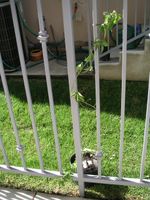
L's garden checkpoint 4: ebay passiflora incense, repotted
Remember we received 3 healthy vines that were each started from seed on July 29th, 2005. M's and my plant died around the 15th of August, and R's died about 1 week later. I ordered another round of plants, to replace our passiflora incense, and also to give some to L so she could drape them on her fence. I repotted M's and my plant on Monday, August 15, but didn't get around to R's repotting until today.
Now we know that the 3-4 week mark is a good indicator of whether the passiflora incense will survive.
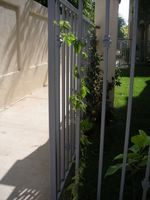
L's garden checkpoint 4: R's new repotted passiflora incense
Next up is L's strongly fragrant jasmine sambac (also known as Arabian jasmine). As I posted earlier, this is the jasmine Chinese people use to flavor certain teas. My mother originally had a larger jasmine sambac, then it died. Later a rather bare cutting started to develop green leaves. Now the plant seems to be thriving in its new locale.
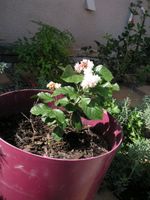
L's garden checkpoint 4: jasmine sambac, healthy growth
Here's E's front door aglaia odorata (Chinese perfume/rice plant). Its fragrance is faint but sweet. L says it reminds her a bit like fragrant tea.
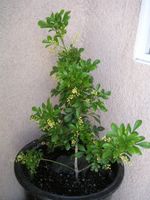
L's garden checkpoint 4: aglaia odorata
I've read a lot about how gardenias can be tricky for some home gardeners, but all the gardenias L purchased seem to be doing well, whether in her little plot, or all over E's garden. Here's one of the $7 gardenia mystery plant's bloom. One reason I can't smell the other fragrant plants that L planted in front of E's house so well (such as osthmanthus fragrans, aglaia odorata) is because of the gardenias strongly wafting scent.

L's garden checkpoint 4: gardenia mystery newly opened blossom
After developing some healthy new leaves, E's mountain apple tree has leaves curling and rolling up in an ugly way. I think it's due to too much water. The sprinklers water the lawn every day for 10 minutes, and the tree is right near a sprinkler. Some of the older leaves are turning yellow and dropping off, solidifying my belief that too much water is to blame.
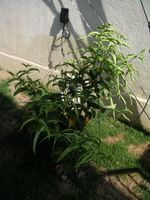
L's garden checkpoint 4: mysterious ailment afflicting mountain apple's new leaves
Here's the fuyu persimmon tree L got last week and plunked down between 2 unknown trees. It's probably still adjusting to being transplanted.
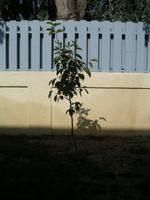
L's garden checkpoint 4: fuyu persimmon tree, adjusting to transplant
Can anyone identify this tree? It is one of many planted by the developer's gardeners before L and E moved into these units.
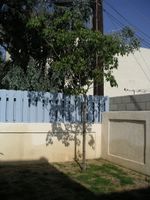
L's garden checkpoint 4: unknown tree, pic 1
Here's a closeup of the leaves; they have serrated edges.
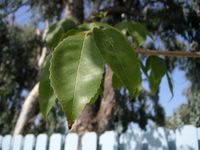
L's garden checkpoint 4: unknown tree, leaves upclose, pic 2
The leaves are palmately compound.

L's garden checkpoint 4: unknown tree, pic 3, backside of leaves
L's guava trees haven't started fruiting yet. On this guava tree only one blossom has opened up. We tried our hands at hand pollinating. The other guava tree as many new blossoms (35+) waiting to open.

L's garden checkpoint 4: sole guava tree blossom
One week later and the Russian "Black Seaman" heirloom tomato plant has grown 2 more fruits, bringing the total count to 3 so far. The tomato from last week has grown noticeable in size within just 1 week. I hope we have enough sunny weather before the rains and cold come in so that the current fruits can ripen.
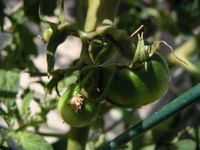
L's garden checkpoint 4: black seaman tomatoes, 1 week later
The Principe Borghese tomato plant looks very stressed. There are > 70 fruits growing now, and only 1 so far noticeably ripened.
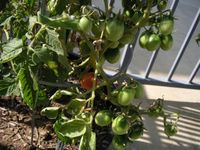
L's garden checkpoint 4: principe borghese tomatoes, 1 week later
There are holes eaten through many leaves, and also through the unripe fruits. I've also seen some caterpillar scat trails around some of the leaves.
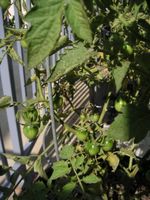
L's garden checkpoint 4: principe borghese tomatoes, with pest scat on leaves
L's pingtung eggplant and sweet genovese basil are growing healthy leaves, but there just isn't enough time for the eggplant to fruit this year. Sigh.
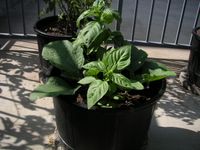
L's garden checkpoint 4: luxurious foliage growth of pingtung eggplant and sweet genovese basil
Omar's Lebanese tomato plant has about 16 tomatoes; they are noticeably larger than the other tomatoes, but they will not likely grow into the 1+ lb monsters this cultivar normally begets. Still, I'm hoping not too many bugs eat holes into these tomatoes.
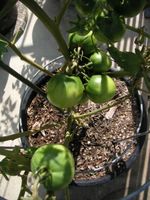
L's garden checkpoint 4: omar's lebanese tomato fruits
The French Carmello variety still only has a handful of fruits. This particular plant is supposed to weather colder weather better than most tomato varieties, so I'm hopeful we'll get a decent yield from this little container plant.

L's garden checkpoint 4: carmello tomato fruits
It's very sad -- the sweet millions hybrid cherry tomato plant started off so strongly, but fungus and bugs and insect-transmitted diseases are slowing down the plant. There are still 40+ cherry tomatoes, but the foliage is looking pretty damn bad. Ah well, it's close to the end of the growing season anyway.
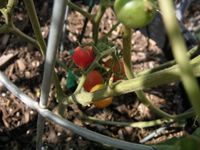
L's garden checkpoint 4: sweet millions ripening fruits
The few fruits we were able to pick (several sweet millions,1 principe borghese) did have a strong concentrated tomato taste. Most of them we picked in order to ripen in the kitchen.
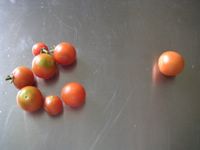
L's garden checkpoint 4: picked sweet millions cherry tomato, and principe borghese tomato
Here's a picture of L's tomato, eggplant, and basil container "garden," with the passiflora edulis in the background.
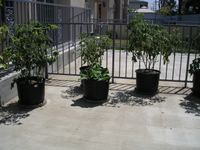
L's garden checkpoint 4: patio edible container garden
Yesterday and today I took the opportunity to pollinate the flowers I saw opening each day. There were four yesterday, and four today. Despite the many flowers opening each day, L's p. edulis still only has 1 fruit.
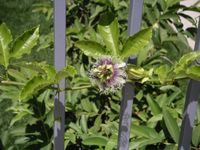
L's garden checkpoint 4: bee pollinating passiflora
Imagine my surprise when, after 3:00 pm, I saw a honey bee come 'round to each flower and pollinate, hours after I had tried to. If fruits eventually develop, I won't know whether hand pollination worked, or whether the bee was essential. Ah well, either way I wouldn't complain.
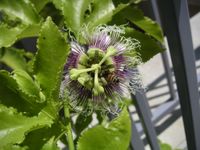
L's garden checkpoint 4: bee pollinating passiflora, up close
I have heard that time of day does determine whether the pollen takes or not. Some people say that when the styles are closer to the upright position earlier in the day/afternoon, there is a better chance of pollination, and the bee didn't come until the stigmas were down lower.
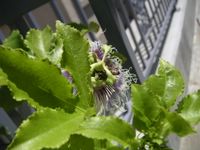
L's garden checkpoint 4: bee pollinating passiflora, up close pic 2
It's interesting the bee finally showed up, since L hasn't noticed many bees in the garden for the past month, only harmful pests and wasps.
Below is L's one and only passionfruit finally starting to turn purple. It's been over 5 weeks, maybe closer to 7 weeks, from when the unripe fruit grew to its final size to when the fruit started to exhibit the purple blush.
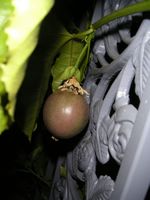
L's garden checkpoint 4: night pic of sole ripening passiflora edulis fruit


0 Comments:
Post a Comment
<< Home